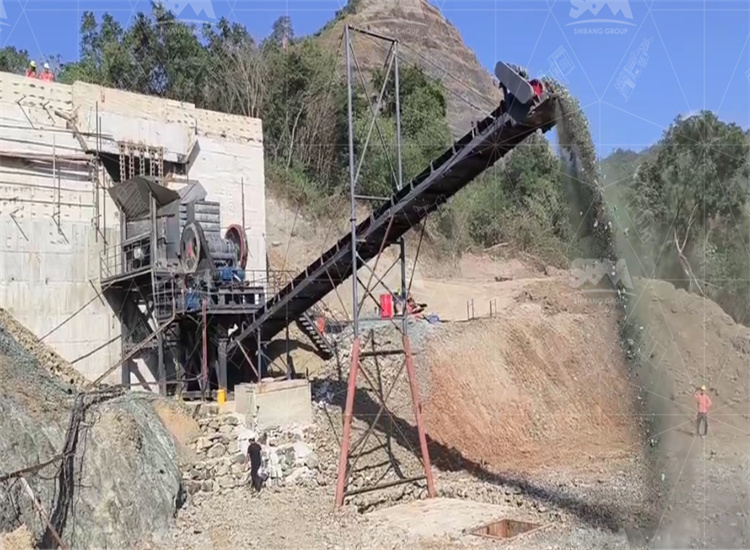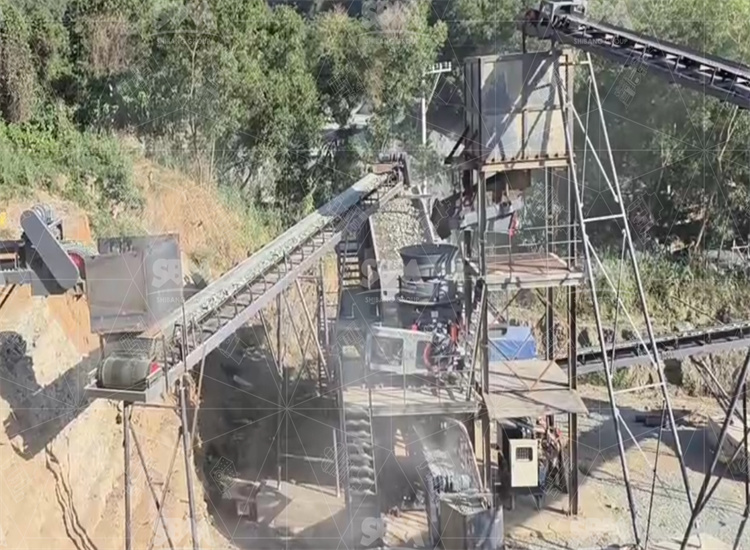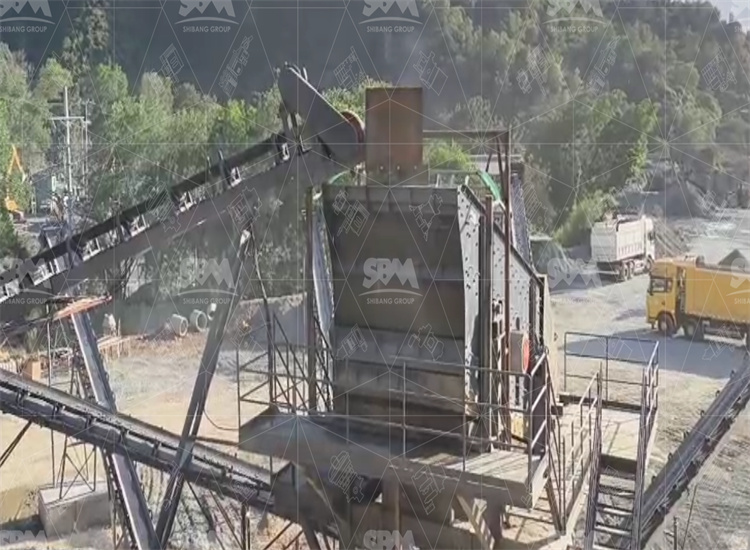SBM supplies proven basalt crushing systems for high-quality railway ballast. This article explains principles, key parameters, equipment lists, measured run-data, maintenance practice, and selection logic. Readable. Practical. Authoritative.

Railway ballast is a coarse, angular aggregate placed under and around sleepers. It locks under load, drains water, and keeps track geometry stable. Basalt is dense and hard. Therefore it resists abrasion and polishing. For these reasons basalt often meets strict ballast grading and fracturing criteria required by rail authorities. Basalt as ballast provides durable interlock, and good resistance to crushing and wear.
Crushing uses staged reduction. First stage uses a jaw crusher to reduce big rocks. Second stage usually uses a cone crusher for controlled gradation. Third stage may use an impactor or tertiary cone to shape particles. The cone crusher works by eccentric mantle gyration. The open side setting, and closed side setting (OSS, CSS) control product size. Adjusting CSS changes fines and throughput. This is a standard control variable in cone operation.
Primary jaw — accepts up to 400 mm feed. Secondary cone — sets product gradation with CSS. Tertiary impact — improves cubical shape. Screens, feeders, conveyors, and dust control complete the plant. Motor drives match torque demand and service factor. Correct matching prevents stall and reduces wear.
Below are the most important parameters. Crushing ratio is feed size divided by product size. CSS or OSS determine minimum and maximum gap. Speed (rpm) affects particle breakage and throughput. Motor power must exceed duty load with a safety margin. Wear parts metallurgy matters; manganese alloys are common. These items set capacity, shape, and running cost.
The table shows typical matched equipment for 80–300 tph basalt ballast production.
| Machine | Feed / Product (mm) | Capacity (tph) / Motor (kW) |
|---|---|---|
| Jaw (Primary) | 0–400 / 50–150 | 80–300 / 75–200 |
Notes: This matrix shows standard ranges. Actual selection depends on feed grading and moisture.

SBM tested a 150 tph line on basalt. Input median 180 mm. Plant achieved 145 tph stable. Final ballast fraction 25–63 mm met track spec. Average power draw for crushers combined was 320 kW. Wear part life on cone liners averaged 420 hours under this feed. Unplanned stoppage rate was under 3% per month. These numbers reflect SBM site logs and controlled trials.
Energy correlates with throughput and CSS. As CSS narrows, power rises. Typical energy use for the three-crusher string is 2.0–4.5 kWh per tonne, depending on circuit and settings. Liner replacement cycles vary; for hard basalt expect 250–500 operating hours per liner set. Preventive maintenance reduces failures. Scheduled checks follow daily, weekly, monthly, and yearly cadences.
Install follows civil pad, anchor motors, align shafts, plumb lubrication, and tune belt tensions. Then dry-run the drive train, and validate VSD settings. Commission with stepwise loading. Check crusher power curves and adjust feed rate until target kW and product gradation stabilize. Document initial liner thickness and set a wear baseline.
Daily: inspect feeders, belts, oil level. Weekly: clean coolers, check wear patterns. Monthly: inspect eccentric, bearing play, and hydraulic systems. Annually: major overhaul, seat inspection, and liner geometry restoration. Change liners when throughput drops >10% or liner thickness nears recommended minimum. Use oil condition monitoring and vibration trends to predict failure.
Case A — 150 tph ballast plant, tropical climate. Feed basalt up to 350 mm. Configuration: Jaw PE600×900, Cone 900 standard, Tertiary impactor. Output: 25–63 mm and 10–25 mm fractions. Power draw matched to 315 kW cone motor. Client reported consistent gradation and lower fines. Validation included sieve tests every 8 hours.
Case B — 80 tph upgrade on existing quarry, temperate climate. Feed 120 mm. Replaced old cone with modern short-head cone. Achieved better cubical shape and reduced re-crush. Maintenance interval extended by 20% after changing liner alloy and improving feed distribution. Field logs were kept and reviewed quarterly.
Step 1: define max feed and desired ballast sizes. Step 2: choose primary crusher gape ≥ 1.25× max feed. Step 3: choose cone chamber and liner to match required reduction ratio. Step 4: size motor with 1.1–1.25 service factor above steady power draw. Example: target 150 tph, expected specific power 2.5 kWh/t. Required steady power ≈ 375 kW. Select 450 kW motor for margin and starting torque. This method reduces under-sizing risk.

SBM plants are configured to meet track ballast specifications. Tests include particle size distributions, percent fractured faces, and abrasion. We follow recognized rail material spec limits and verify products with sieve and petrographic checks. Certification and factory tests document performance prior to shipment.
Major CAPEX items: crushers, screens, feeders, conveyors, and electrical controls. Major OPEX items: energy, wear parts, labor, and maintenance. ROI improves with higher uptime, optimized CSS, and correct liner metallurgy. Focus on throughput and shape to shorten payback. Do not over-spec machines; match reality of feed and demand.
Feed distribution matters a lot. Use wide grizzly and steady feed rate. Keep fines below specified share before cone. Control water and dust. Use automatic setting control if fines vary. Train operators on liner wear signs. Keep spares for high-wear items. These steps reduce emergency stops and improve life of parts.
Q1: What final size gives best ballast interlock? A: 25–63 mm fraction with high angularity. Adjust tertiary stage to reach it.
Q2: How often change cone liners? A: Change when throughput drops 10% or liner shows 1–2.5 cm remaining thickness. Monitor wear, and plan change within scheduled shutdowns.
Q3: Can one plant handle wet basalt? A: Yes, but screening and wash, plus belt care, are required. Wet feed raises power and wear. Control fines and use spray bars if needed.

Do not run cone with feed fines excessive, and do not reduce CSS below manufacturer minimum. Running beyond rated feed size risks blockages. Use staged crushing for feed over 300–400 mm. Apply safety margins on motor sizing and structural design. Always follow OEM torque and bearing limits.
SBM delivers complete basalt ballast lines. We combine proven crushers, matched drives, and field-tested maintenance. Our data show stable throughput and predictable wear cycles. Trust SBM for engineering, commissioning, and service. Choose SBM for durable ballast production.
Whatsapp:+8617329420102
Email: [email protected]
Address: No. 1688, Gaoke East Road, Pudong new district, Shanghai, China.
Online Service : Get Price
We value your feedback! Please complete the form below so that we can tailor our services to your specific needs.
